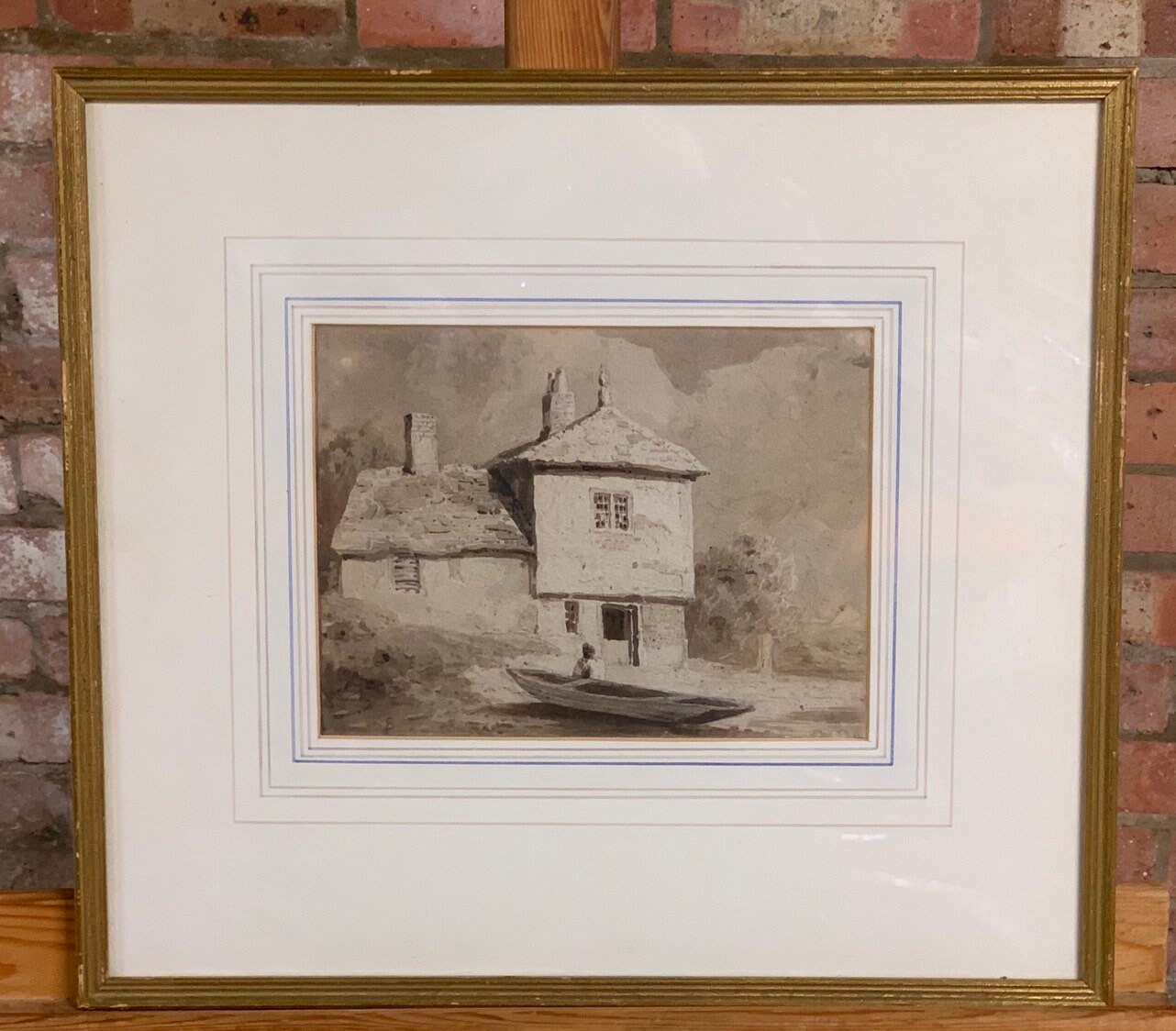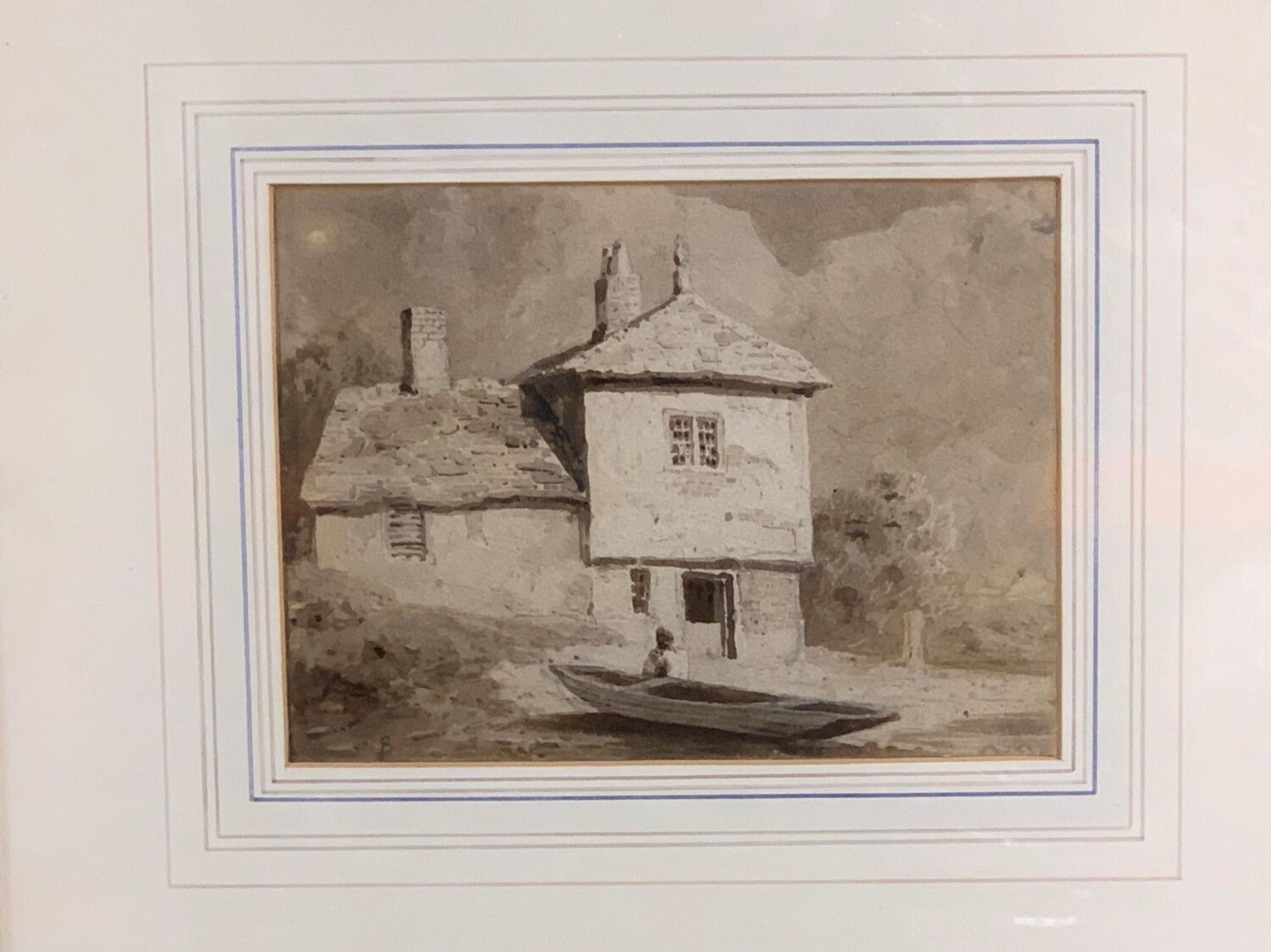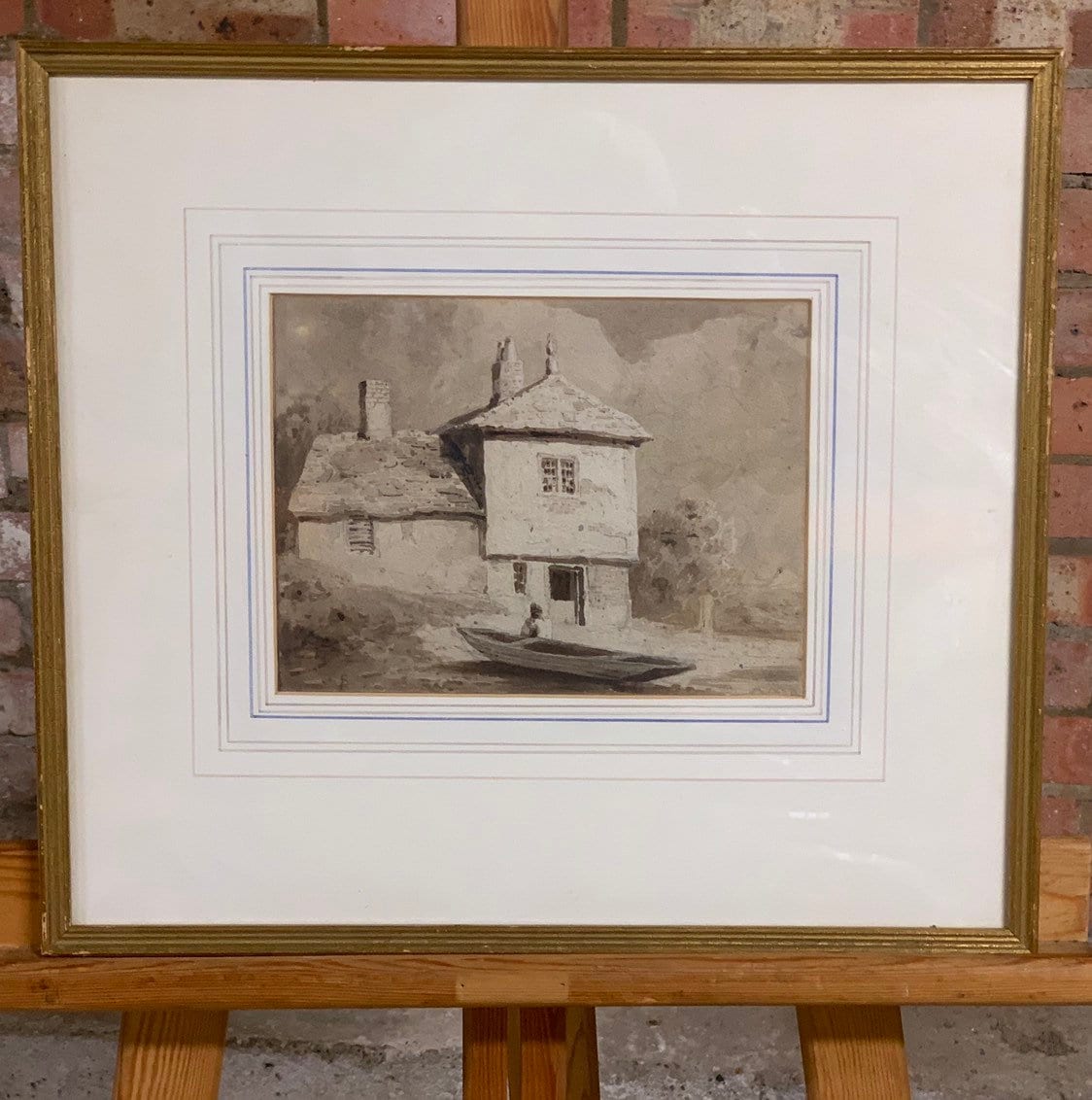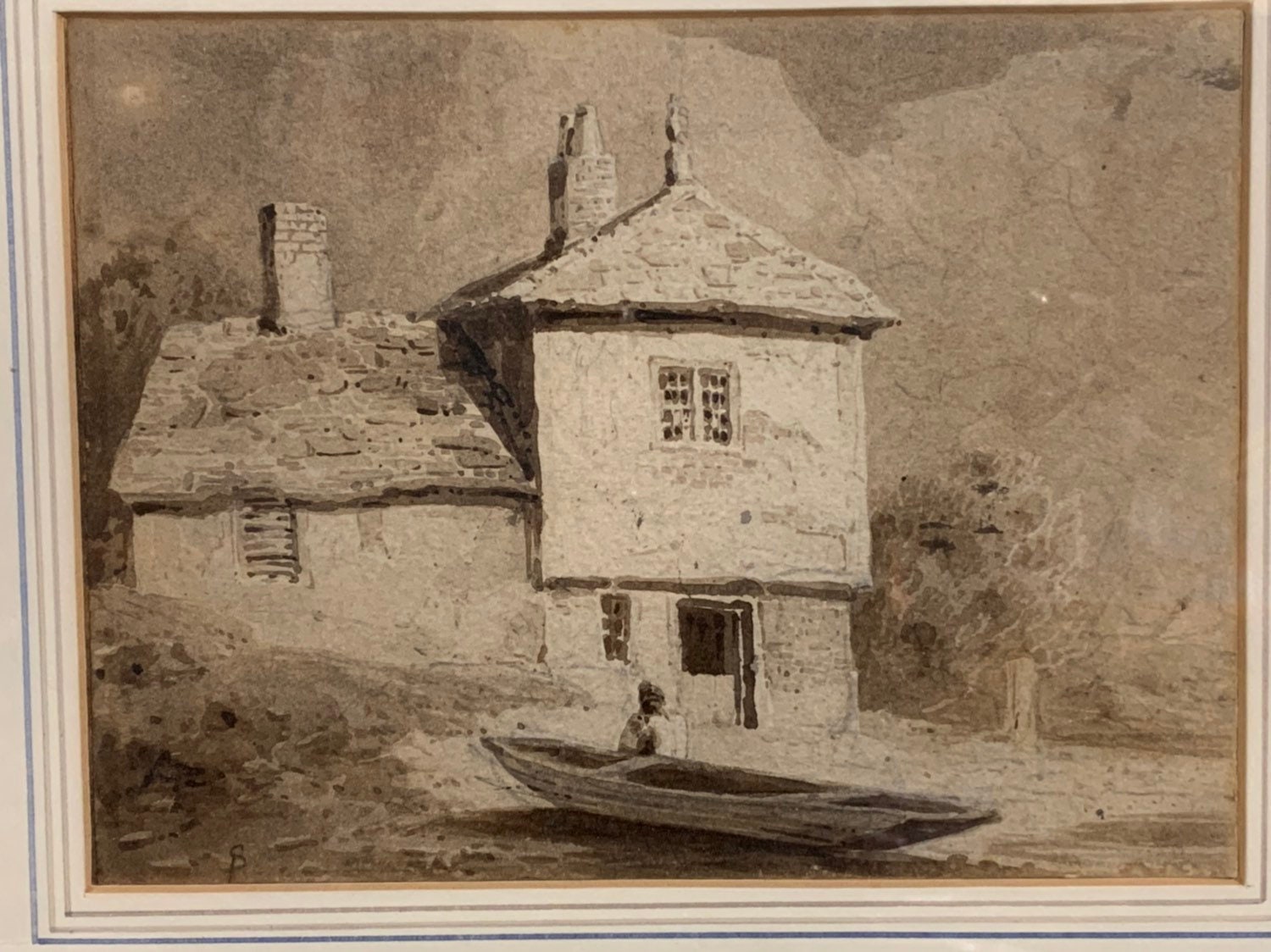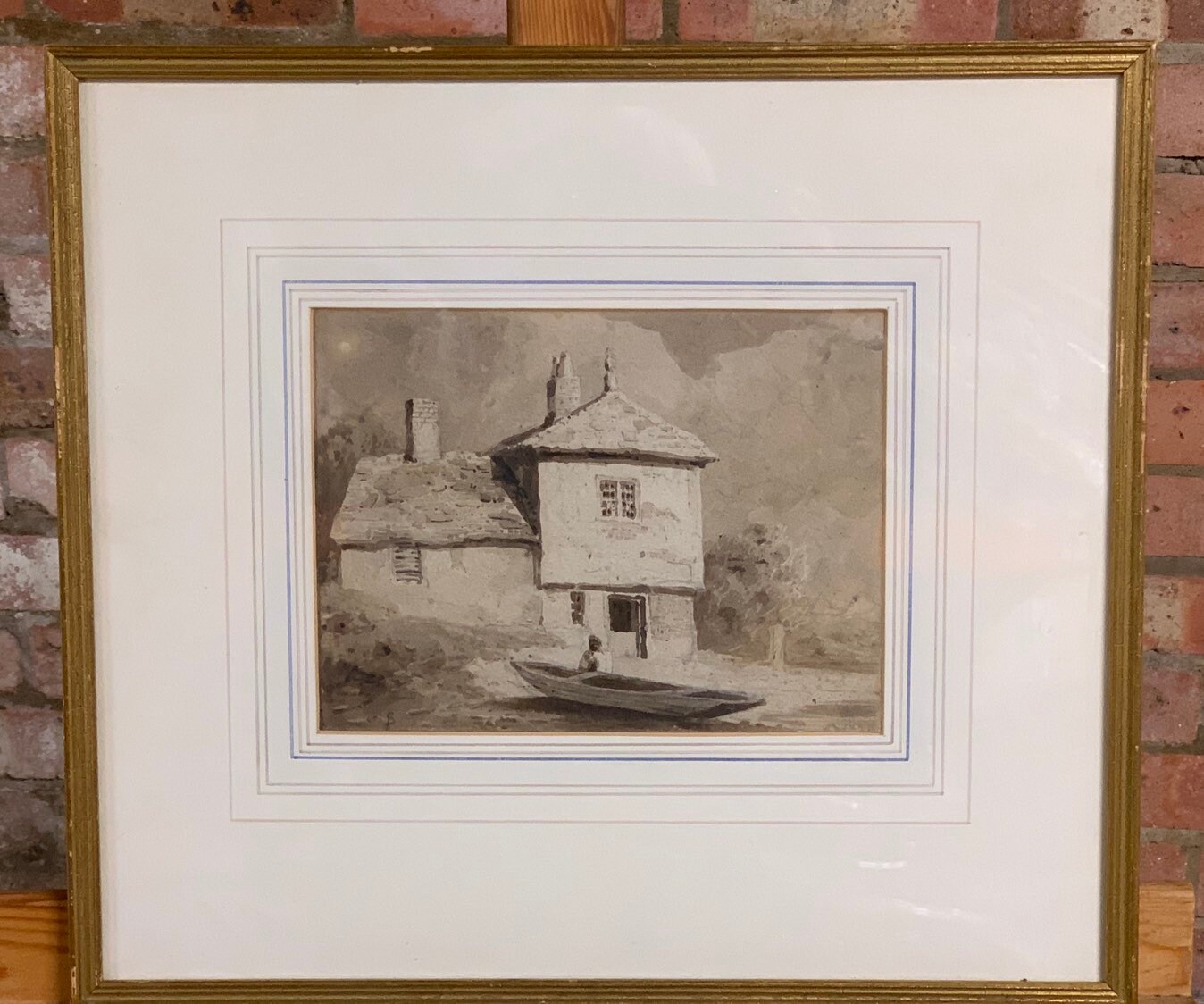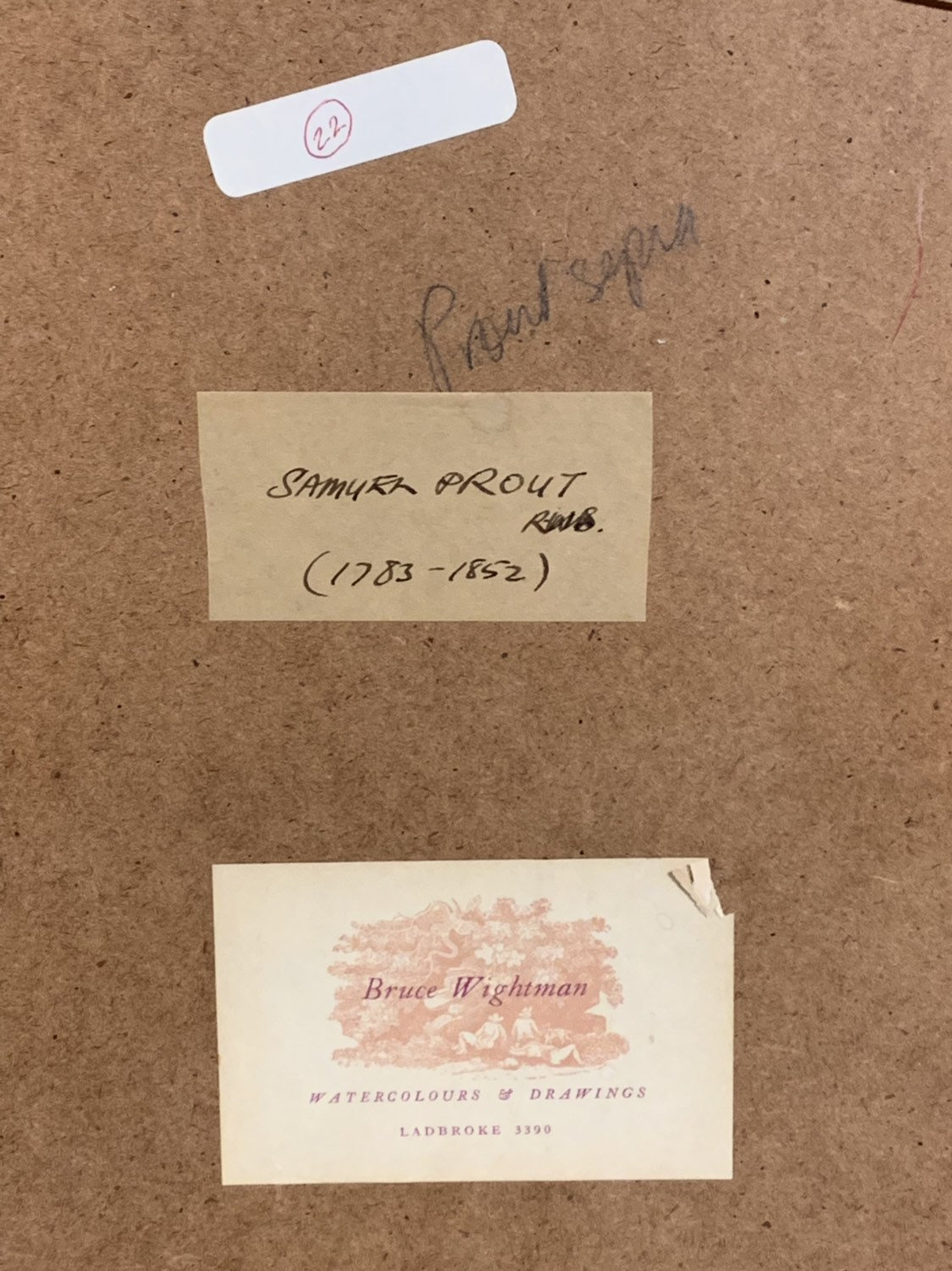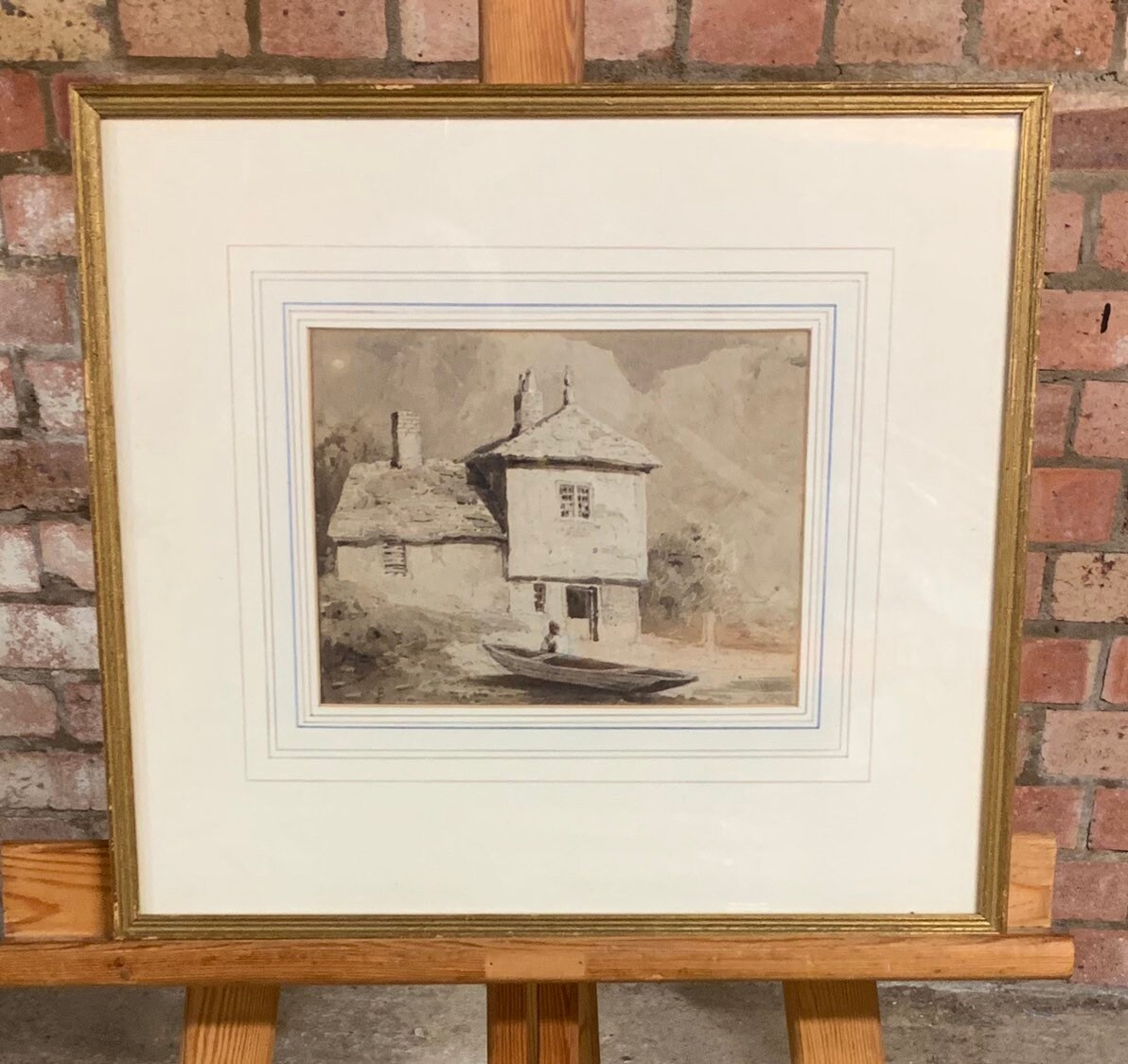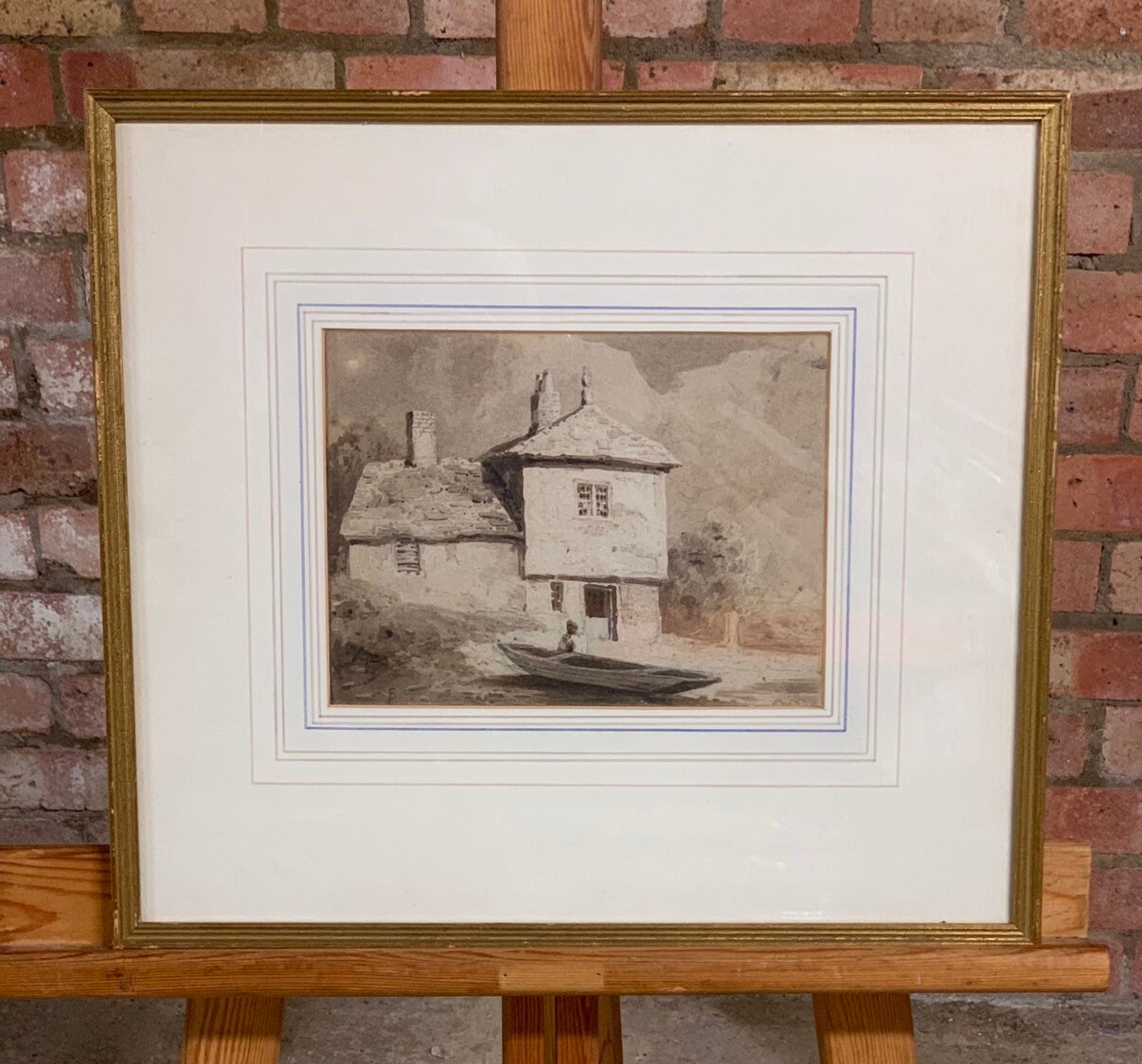Original Early 19th Century Watercolour By Samuel Prout One Of The Masters!!
$1,326.45
Original Early 19th Century Watercolour by Samuel Prout
SAMUEL PROUT OWS AA (1783-1852)
Despite persistent ill health, Samuel Prout developed
as a highly distinctive topographical artist and
undertook regular sketching tours, first in Britain
and later on the Continent. The resulting images of
ancient buildings at their most picturesque were
highly popular and influential – as exhibition
watercolours and, especially, lithographic illustrations.
Samuel Prout was born at Trevil Street, Plymouth, Devon, on
17 September 1783, the fourth of fourteen children of a shopkeeper
and naval outfitter. As a child, he suffered from severe sunstroke, which
gave him violent headaches for the remainder of his life. They were so
debilitating that he had to take to his bed once or twice a week until
his marriage in 1810. He was also victim to chronic lung congestion.
Prout made sketches and copied prints as a young child, and received
encouragement from his headmaster, the Rev John Bidlake, when he
attended Plymouth Grammar School. He was also given some lessons
from Thomas H Williams. The Plymouth area became well known to
him through the many sketching expeditions he undertook with his
friend and fellow pupil, Benjamin Robert Haydon, who became a
history painter.
Haydon’s father was a printer, publisher and bookseller, who kept a
shop in the Market Place in Plymouth. There, in 1801, Prout met the
budding antiquary, John Britton, who was in town to look for materials
for the projected topographical survey, Beauties of England and Wales.
(This collaboration with E W Brayley was published in parts between 1803 and 1815).
Prout joined Britton on a tour of Cornwall, in order to make drawings for Beauties, but he had problems with the perspective of the buildings, and had to work hard through the following year in order to improve his skills.
Aware of the artist’s potential, Britton persuaded Prout to move to London in 1802, and live with him at his home, 21 Wilderness Row, Clerkenwell. There he entered a circle of topographical illustrators that included Frederick Mackenzie and George Sidney Shepherd. He was set to copy the work of leading contemporary watercolourists, including William Alexander, J M W Turner, John Sell Cotman, Thomas Girtin and Thomas Hearne, the last three having a particular influence on his early style. He was also sent on sketching tours of Cambridgeshire, Essex and Wiltshire during the years 1803 and 1804, as preparation for work on Beauties and The Architectural Antiquities of Great Britain (5 vols, 1806-26). During the same period, he began to exhibit at the Royal Academy of Arts and make useful contacts with dealers, including Thomas Palser of Surrey Side, Westminster Bridge, who was the earliest purchaser of his work.
In 1805, Prout became so ill that he had to return to Plymouth,
though he was well enough to make a sketching tour of Devon and Cornwall in the October of that year. During his prolonged stay at home, he gave Charles Lock Eastlake his first drawing lessons.
By 1808, Prout had returned to London, and was living at 55 Poland Street, Soho. He brought with him many West Country coastal scenes, which he exhibited at the Royal Academy, the British Institution and the Associated Artists in Water Colours (becoming a member of the last in 1810, and remaining so until its demise in 1812). These scenes would also provide the basis for Picturesque Delineations in the Counties of Devon and Cornwall, published by Palser in 1812. Establishing himself as a drawing master, Prout taught at Dr William Glennie’s academy in Dulwich Grove, from 1809 to 1821, during which time his pupils included (the Rev) J D Glennie and William Henry Harriott, two future amateur artists. He also attracted a private clientele of about thirty, one of his first pupils being James Duffield Harding (who followed Prout to become a landscape painter and lithographer).
Marrying in Brixton in 1810, Prout and his wife moved into 4 Brixton
Place (now part of Brixton Road) in the following year. (Together, they would have four children.) Once settled, he began to capitalise on his teaching, by producing a series of drawing books for the use of the beginners, starting with Rudiments of Landscape in Progressive Studies (1813, containing 16 aquatints). Over three decades, Prout issued
fourteen publications, which, while falling into either drawing manuals or volumes of topographical plates, together promoted the taste for the Picturesque.
Not neglecting his career as an exhibiting artist, Prout began to show work at the Society of Painters in Oil and Water-Colours in 1815, becoming an associate in 1817 and a member in 1819. (The society returned to its former name of the Society of Painters in Water Colours in 1821.)
Prout’s style and subject matter were profoundly affected by his first Continental sketching tour, to Northern France in 1819. Keen to meet the challenge of recording the ancient architecture in all its
atmospheric detail, he found inspiration in the recent drawings of Norman buildings by Henry Edridge. The death of Edridge in 1821 left the way free for Prout to exploit the genre, and his regular travels (until 1846) provided him with constant material.
Through the 1820s, Prout took in France, the Low Countries,
Germany (including the Rhineland and Bavaria), and Italy (of which
Venice proved an inevitable highlight). Sometimes, he travelled and sketched in the company of other artists, as with Richard Parkes Bonington in St Omer (1822).
In order to reproduce his graphic responses accurately and vividly,
Prout turned from aquatint to lithography, as is seen to great effect in Picturesque Buildings in Normandy (1821, printed by Charles Hullmandel) and Illustrations of the Rhine (1822-26). The most notable later volumes included Facsimiles of Sketches made in Flanders and Germany (1833) and
Facsimiles of Sketches made in France, Switzerland and Italy (1839).
The breadth of his travels, and the resulting range of images, ensured Prout a strong reputation on both sides of the Channel, a reputation that reached its height around 1830. His contacts in the Parisian art world included Baron Isidore Taylor, who helped him to show watercolours at the Paris Salon of 1824, and who, in the following year, included lithographs of his work in the third volume of Voyages pittoresques et romantiques dans l’ancienne France (produced by Taylor in
collaboration with Charles Nodier).
Back in England, Prout received a number of honours and mixed
freely with fellow leading artists. In 1829, George IV appointed him
‘Painter in Water-Colours in Ordinary to His Majesty’, an honour renewed by both William IV and Queen Victoria; while, a year later, he became a fellow of the Society of Antiquaries. During the early 1830s, he regularly attended the Artists’ and Amateurs’ Conversazione,
where he met with Thomas Shotter Boys, John Sell Cotman,
David Cox, David Roberts and Clarkson Stanfield.
However, in 1836, ill health drove Prout from London to Hastings,
where he spent eight years in what he regarded as exile. On his return to the capital, in 1845, he settled at 5 De Crespigny Terrace, where he became a neighbour of the young critic, John Ruskin, who was a great admirer of his work. Making his last Continental tour, to Normandy, in 1846, he then produced gradually less work until his death at home on 10 February 1852. His studio sale was held at Sotheby’s on
19-22 May 1852.
Prout’s distinctive style, and Ruskin’s promotion of it, continued to prove highly influential. What may be termed the Prout effect was sustained into the late nineteenth century by Samuel Gillespie Prout and John Skinner Prout (respectively his son and nephew), and also
through aspects of the work of T R C Dibdin and Louis Haghe.
In 1879, the Fine Art Society published Notes by Ruskin on Samuel Prout and William Hunt illustrated by A Loan Collection of Drawings.
His work is represented in numerous public collections, including the British Museum, The Courtauld Gallery, Tate and the V&A; The Fitzwilliam Museum (Cambridge), Manchester Art Gallery, Plymouth City Museum and Art Gallery, Royal Cornwall Museum (Truro),
Southampton Art Gallery and The Whitworth Art Gallery (Manchester). Prout joined Britton on a tour of Cornwall, in order to make drawings
for Beauties, but he had problems with the perspective of the buildings,
and had to work hard through the following year in order to improve
his skills.
Aware of the artist’s potential, Britton persuaded Prout to move to London in 1802, and live with him at his home, 21 Wilderness Row, Clerkenwell. There he entered a circle of topographical illustrators that included Frederick Mackenzie and George Sidney Shepherd.
He was set to copy the work of leading contemporary watercolourists, including William Alexander, J M W Turner, John Sell Cotman, Thomas Girtin and Thomas Hearne, the last three having a particular influence on his early style. He was also sent on sketching tours of Cambridgeshire, Essex and Wiltshire during the years 1803 and 1804, as preparation for work on Beauties and The Architectural Antiquities of Great Britain (5 vols, 1806-26). During the same period, he began to exhibit at the Royal Academy of Arts and make useful contacts with dealers, including Thomas Palser of Surrey Side, Westminster Bridge, who was the earliest purchaser of his work.
In 1805, Prout became so ill that he had to return to Plymouth,
though he was well enough to make a sketching tour of Devon and Cornwall in the October of that year. During his prolonged stay at home, he gave Charles Lock Eastlake his first drawing lessons.
By 1808, Prout had returned to London, and was living at 55 Poland Street, Soho. He brought with him many West Country coastal scenes, which he exhibited at the Royal Academy, the British Institution and
the Associated Artists in Water Colours (becoming a member of the last in 1810, and remaining so until its demise in 1812). These scenes would also provide the basis for Picturesque Delineations in the Counties of Devon and Cornwall, published by Palser in 1812.
Establishing himself as a drawing master, Prout taught at Dr William
Glennie’s academy in Dulwich Grove, from 1809 to 1821, during
which time his pupils included (the Rev) J D Glennie and William
Henry Harriott, two future amateur artists. He also attracted a private clientele of about thirty, one of his first pupils being James Duffield Harding (who followed Prout to become a landscape painter and lithographer).
Marrying in Brixton in 1810, Prout and his wife moved into 4 Brixton
Place (now part of Brixton Road) in the following year. (Together, they would have four children.) Once settled, he began to capitalise on his teaching, by producing a series of drawing books for the use of the
beginners, starting with Rudiments of Landscape in Progressive Studies
(1813, containing 16 aquatints). Over three decades, Prout issued
fourteen publications, which, while falling into either drawing manuals or volumes of topographical plates, together promoted the taste for
the Picturesque.
Not neglecting his career as an exhibiting artist, Prout began to show work at the Society of Painters in Oil and Water-Colours in 1815, becoming an associate in 1817 and a member in 1819. (The society returned to its former name of the Society of Painters in Water Colours in 1821.)
Prout’s style and subject matter were profoundly affected by his first Continental sketching tour, to Northern France in 1819. Keen to meet the challenge of recording the ancient architecture in all its
atmospheric detail, he found inspiration in the recent drawings of Norman buildings by Henry Edridge. The death of Edridge in 1821 left the way free for Prout to exploit the genre, and his regular travels (until 1846) provided him with constant material.
Through the 1820s, Prout took in France, the Low Countries,
Germany (including the Rhineland and Bavaria), and Italy (of which
Venice proved an inevitable highlight). Sometimes, he travelled and sketched in the company of other artists, as with Richard Parkes
Bonington in St Omer (1822).
In order to reproduce his graphic responses accurately and vividly,
Prout turned from aquatint to lithography, as is seen to great effect in Picturesque Buildings in Normandy (1821, printed by Charles Hullmandel)
and Illustrations of the Rhine (1822-26). The most notable later volumes included Facsimiles of Sketches made in Flanders and Germany (1833) and
Facsimiles of Sketches made in France, Switzerland and Italy (1839).
The breadth of his travels, and the resulting range of images, ensured Prout a strong reputation on both sides of the Channel, a reputation that reached its height around 1830. His contacts in the Parisian art world included Baron Isidore Taylor, who helped him to show watercolours at the Paris Salon of 1824, and who, in the following year, included lithographs of his work in the third volume of Voyages
pittoresques et romantiques dans l’ancienne France (produced by Taylor in collaboration with Charles Nodier).
Back in England, Prout received a number of honours and mixed
freely with fellow leading artists. In 1829, George IV appointed him
‘Painter in Water-Colours in Ordinary to His Majesty’, an honour renewed by both William IV and Queen Victoria; while, a year later, he became a fellow of the Society of Antiquaries. During the early 1830s, he regularly attended the Artists’ and Amateurs’ Conversazione,
where he met with Thomas Shotter Boys, John Sell Cotman,
David Cox, David Roberts and Clarkson Stanfield.
However, in 1836, ill health drove Prout from London to Hastings,
where he spent eight years in what he regarded as exile. On his return to the capital, in 1845, he settled at 5 De Crespigny Terrace, where he became a neighbour of the young critic, John Ruskin, who was a great admirer of his work. Making his last Continental tour, to Normandy, in 1846, he then produced gradually less work until his death at home
on 10 February 1852. His studio sale was held at Sotheby’s on
19-22 May 1852. Prout’s distinctive style, and Ruskin’s promotion of it, continued to prove highly influential. What may be termed the Prout effect was sustained into the late nineteenth century by Samuel Gillespie Prout
and John Skinner Prout (respectively his son and nephew), and also
through aspects of the work of T R C Dibdin and Louis Haghe.
In 1879, the Fine Art Society published Notes by Ruskin on Samuel Prout and William Hunt illustrated by A Loan Collection of Drawings.
His work is represented in numerous public collections, including the British Museum, The Courtauld Gallery, Tate and the V&A; The Fitzwilliam Museum (Cambridge), Manchester Art Gallery, Plymouth
City Museum and Art Gallery, Royal Cornwall Museum (Truro),
Southampton Art Gallery and The Whitworth Art Gallery (Manchester).
The frame measures approx 41.5cm x 37.5cm
Note for USA customers
N.B as of Aug 2025 USA has introduced new import duty tariffs which are charged regardless of however much the item costs (previously it was only charged on items over $800 but this has now changed).So please be aware there will be some increase costs on shipping to take into account the import duties. Please feel free to message me if you are interested in purchasing this or other items and need any additional information with regards to shipping costs.
Thank you
Frequently Asked Questions
Does OnlineAntiques Ship Worldwide?
In most cases we do ship overseas from the UK depending on size and weight. However if we haven’t listed a shipping cost to your country please message us as we are always happy to obtain an individual shipping price
How Quick Does OnlineAntiques Dispatch items ?
In most cases we dispatch within 48hrs and we use either a 24hr or 48hr signed for delivery service. If the item is large, such as an item of furniture then it will take 5-7days as we will need to arrange a private courier
Gift wrapping and packaging
We package our items extremely well to ensure fragile items and artwork arrive safely. If you would like your purchase gift wrapped then please add a message or message us directly with details. We are always happy to help as much as possible for that special occasion.
Multiple purchases
If you are purchasing multiple items and we can package together, we can reduce postage/shipping costs. Please message us direct ahead of your purchase so we can make the necessary postal adjustments to your purchases.

